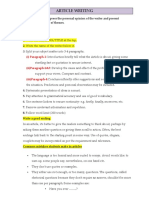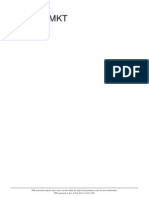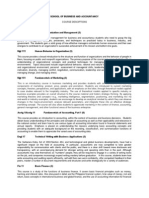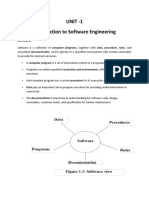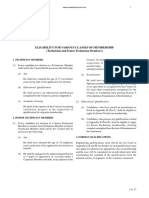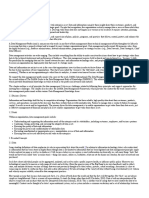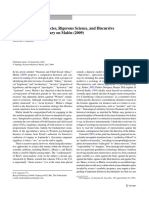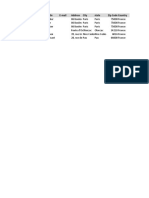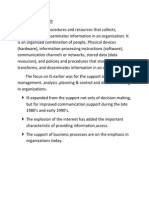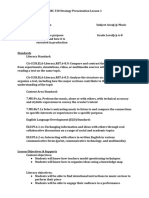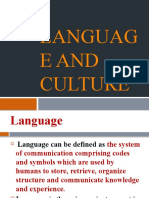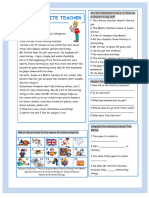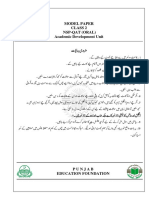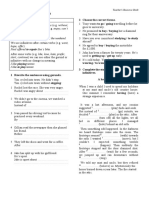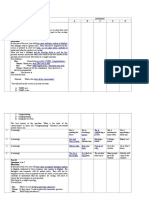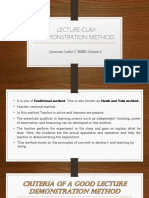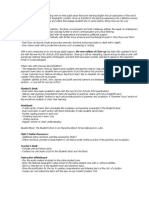Professional Documents
Culture Documents
Business Information Systems: © The Institute of Chartered Accountants of India
Business Information Systems: © The Institute of Chartered Accountants of India
Uploaded by
Sashidhar PrasadOriginal Title
Copyright
Available Formats
Share this document
Did you find this document useful?
Is this content inappropriate?
Report this DocumentCopyright:
Available Formats
Business Information Systems: © The Institute of Chartered Accountants of India
Business Information Systems: © The Institute of Chartered Accountants of India
Uploaded by
Sashidhar PrasadCopyright:
Available Formats
4 Business Information Systems
4.1 Introduction
Information technologies, including Internet-based information systems, are playing
vital and expanding roles in business. Information technology can help all kinds of
businesses improve the efficiency and effectiveness of their business processes,
managerial decision making and workgroup collaboration, which strengthens their
competitive positions in rapidly changing market places. Business Information
Systems (BIS) is a preferred software engine for the development of Information
Technology (IT) in most recent years. This chapter summarizes in about various
Information Systems, their application and their impact on organizations.
4.2 Information Technology as a Key Business Enabler &
Driver
Information represents an organization’s tangible and intangible resources and all
transactions relating to those resources. Information influences the way an organization
operates. The right information, if it is transported to the right person, in the right
fashion, and at the right time, can progress and guarantee organizational effectiveness
and competence. The BIS is the mechanism used to manage and control the information
resource.
4.3 Information Systems
Information System: An Information System (IS) is a combination of people,
hardware, software, communication devices, network and data resources that processes
(can be storing, retrieving, transforming information) data and information for a specific
purpose. Any specific Information System aims to support operations, management
and decision-making.
4.3.1 Components of Information System
The main aim and purpose of each Information System is to convert the data into
information which is useful and meaningful. People, Hardware, Software, and Data
Resources are four basic resources of Information Systems; a process is required to
convert data into information for end users. Any Information process consists of input,
processing, output, storage, and control processes.
Business Information System: Business Information Systems (BIS) may be defined
as systems integrating Information Technology, people and business.
© The Institute of Chartered Accountants of India
4.2 Information Technology
4.4 Organizations, Information Systems and Business
Processes
Business Process: A Business Process is an activity or set of activities that will accomplish
a specific organization goal. A business process has a goal, specific inputs and outputs,
uses resources, and has a number of activities that are performed in some order, creates
value of some kind for the customer and may affect more than one organizational unit.
4.5 Information Systems and their role in Businesses
Many business organizations obtain a competitive advantage by employing new
information systems. The backbone of Information System is the World Wide Web,
Internet; or within a business a Local Area Network (LAN), along with EDI, EIS, ERP,
SCM, e-CRM, e-Commerce and host of others, which portray new ways in which IS can
be employed to cultivate business.
4.6 Types of Information Systems
Types of Description Example Groups
Information Served
Systems
Strategic - Used for strategic managers to track and ESS For Senior
Level deal with strategic issues, assisting long- Managers
Systems range planning.
Management Used for the monitoring, controlling, MIS and Middle
-Level decision-making, and administrative DSS Managers
Systems activities of middle management.
Knowledge - These systems support discovery, KWS and Knowledge
Level processing and storage of knowledge OAS and Data
Systems and data workers. These further control Workers
the flow of paper work and enable group
working.
Operational - Support operational managers tracking TPS Operational
Level elementary activities that include Managers
Systems tracking customer orders, invoice
tracking, etc. Operational-level systems
ensure that business procedures are
followed.
4.6.1 Transaction Processing System (TPS)
A Transaction Processing System (TPS) may be defined as a type of information
system that collects, stores, modifies and retrieves the day-to-day data transactions of an
enterprise. The pre-requisites of ACID Test for any TPS are Atomicity, Consistency,
Isolation and Durability.
© The Institute of Chartered Accountants of India
Business Information Systems 4.3
4.6.2 Office Automation System (OAS)
Office Automation System (OAS) is amalgamation of hardware, software, and other
resources used to smooth the progress of communications and augment efficiency.
Office automation refers to the use of computer and software to digitally generate,
collect, store, manipulate, and relay office information needed for accomplishing basic
tasks and goals.
4.6.3 Knowledge Management System (KMS)
Knowledge Management System (KMS) refer to any kind of IT system that stores
and retrieves knowledge, improves collaboration, locates knowledge sources, mines
repositories for hidden knowledge, captures and uses knowledge, or in some other way
enhances the KM process. Explicit and Tacit are two broad types of knowledge. A
Knowledge discovery in database system is a value – added Intranet with facilities to
search and identify captured knowledge or identify experts who have the knowledge.
Knowledge Discovery and Data Mining (KDD) fundamentally deals with ways and
means of capturing and making obtainable knowledge of the experts to others, in
electronic form. KDD systems also assist us establish, contact and communicate with
experts (knowledgeable people) on various subjects, surrounded by our organization, or
perhaps even outside.
4.6.4 Management Information System (MIS)
Most simply, Management Information System is an integrated, user-machine system for
providing information to support operation, management and decision-making functions in
an organization. In other words, Management Information System is a system which
provides accurate, timely and meaningful data for management planning, analysis and control
to optimize the growth of the organization. For example - Airline reservations (seat, booking,
payment, schedules, boarding list, special needs, etc.), Bank operations (deposit, transfer,
withdrawal) electronically with a distinguish payment gateways, etc.
4.6.5 Decision Support System (DSS)
A Decision Support System (DSS) is a computer-based information system that
supports business or organizational decision-making activities. DSSs serve the
management, operations, and planning levels of an organization (usually mid and higher
management) and help to make decisions, which may be rapidly changing and not easily
specified in advance. DSS can be either fully computerized, human or a combination of
both. DSS has four basic components: The user, one or more databases, Planning
languages and Model Base.
4.6.6 Executive Information Systems (EIS)
An Executive Information System (EIS) is the nature of IS used by executives to
access and administer the data they entail to make informed business decisions. Even
though there are tools for managing an Executive Information System, the EIS in itself
is not an instrument, but rather, an infrastructure within a company. Components of an
EIS are Hardware, Software, User Interface and Telecommunication.
© The Institute of Chartered Accountants of India
4.4 Information Technology
4.7 Specialized Systems
Specialized Systems provide comprehensive end to end IT solutions and services
(including systems integration, implementation, engineering services, software
application customization and maintenance) to various sectors to confront challenges,
and convert every challenge into an opportunity. For example- ERP, SCM, CRM, HRMS
etc.
4.7.1 Enterprise Resource Planning (ERP)
Enterprise Resource Planning (ERP) systems integrate internal and external
management information across an entire organization—taking on finance/accounting,
manufacturing, sales and service, customer relationship management etc., and control
the connections to exterior stakeholders.
Diverse stages involved in ERP implementation are - Inventory Control, ABC Analysis,
Economic Order Quantity (EoQ), Just-In-Time (JIT), Material Requirement Planning
(MRP-I), Manufacturing Resource Planning – II (MRP-II), Distribution Resource
Planning (DRP), Enterprise Resource Planning (ERP), Money Resource Planning (MRP-
III) and EIS-Web Enabled. Some of the "popular" ERP packages are SAP, JD Edwards,
Baan, Oracle 9 i.
4.7.2 Customer Relationship Management (CRM)
Customer Relationship Management (CRM) may be defined as a business process
in which client relationships; customer loyalty and brand value are built through
marketing strategies and activities. CRM allows businesses to develop long-term
relationships with established and new customers while helping modernize corporate
performance. CRM incorporates commercial and client-specific strategies via employee
training, marketing planning, relationship building and advertising.
CRM establishes the benefits of generating customer loyalty, raising a market intelligence
enterprise and an integrated relationship. CRM applications smoothen the progress to
capture, consolidate, analysis and enterprise-wide dissemination of data from existing
and potential customers.
4.7.3 Supply Chain Management (SCM)
Supply Chain Management (SCM) is a chain that starts with customers and ends with
customers. It may be defined as the process of planning, implementing and controlling
the operations of the supply chain with the purpose of satisfying the customer's
requirement as efficiently as possible. Supply Chain spans all movement and storage of
raw materials, Work-in-process, inventory and finished goods from the point of origin
to the point of consumption. Components of SCM are Procurement/Purchasing,
Operations, Distribution and Integration.
© The Institute of Chartered Accountants of India
Business Information Systems 4.5
4.7.4 Human Resource Management Systems (HRMS)
A Human Resources Management System (HRMS) is a software application that coalesce
many human resources functions, together with benefits of administration, payroll, recruiting
and training, and performance analysis and assessment into one parcel. In other words,
HRMS or Human Resources Information System (HRIS) refers to the systems and processes
at the intersection between Human Resource Management (HRM) and Information
Technology.
Some of the key modules of HRMS are Workforce Management, Time and Attendance
Management, Payroll Management, Training Management, Compensation
Management, Recruitment Management, Personnel Management, Organizational
Management, Employee Self Service (ESS) and Analytics.
4.7.5 Core Banking System (CBS)
Nowadays, most banks use core banking applications to sustain their operations where
CORE stands for "Centralized Online Real-time Environment". Core Banking
System (CBS) may be defined as the set of basic software components that manage the
services provided by a bank to its customers through its branches (branch network). In
other words, the platform where communication technology and information technology
are merged to suit core needs of banking is known as Core Banking Solutions (CBS).
Normal core banking functions will include deposit accounts, loans, mortgages and
payments. Banks make these services available across multiple channels like ATMs,
Internet banking, and branches.
4.7.6 Accounting Information System (AIS)
Accounting Information System (AIS) is defined as a system of collection, storage
and processing of financial and accounting data that is used by decision makers. AIS is
generally a computer-based method for tracking accounting activity in conjunction with
information technology resources. The resulting statistical reports can be used internally
by management or externally by other interested parties including investors, creditors
and tax authorities. Six key elements that compose the typical Accounting Information
System are People, Procedures and Instructions, Data, Software, Information
Technology Infrastructure and Internal controls.
4.8 Artificial Intelligence
Artificial Intelligence (AI) is a research field that studies how to comprehend the
intelligent human behaviors on a computer. The decisive objective of AI is to make a
computer that can discover, sketch, and crack problems in parallel. Expert systems,
Pattern Recognition, Natural language processing, and many others are some of the
various purposes on which AI may be applied.
4.9 Expert System
An Expert System (ES) is a computerized information system that allows non-experts
to make decisions comparable to those of an expert. The aim of the Expert System is to
have a team of seasoned specialists holding industry-wide experience who further spread
across implementations. Expert system takes into consideration Knowledge base,
Database of facts, Inference Engine, Explanation mechanism and User Interface. Expert
Systems can be Example-based, Rule-based or Frame-based.
© The Institute of Chartered Accountants of India
4.6 Information Technology
4.10 Business Intelligence
Business Intelligence (BI), in simple words, refers to the process of collecting and
refining information from many sources, analyzing and presenting the information in
useful ways so that users can make better business decisions. BI enables managers to see
things with more clarity, and empowers them to peek into the possible future.
4.10.1 Business Intelligence Tools
Business Intelligence Tools are a type of software that is designed to retrieve, analyze and report
data. Some of the key Business Intelligence tools are Simple Reporting and Querying, Business
Analysis, Dashboards, Scorecards, and Data Mining or Statistical Analysis.
4.10.2 Business Reporting through MIS and IT
Business Intelligence (BI) caters to strategic, tactical and operational needs and
provides a platform for complete, comprehensive performance management for today's
global, competitive businesses. Business reports are routinely assigned to facilitate us to
accomplish conclusions about a trouble or issue; demonstrate short and apparent
communication skills; endow with recommendations for upcoming accomplishing;
exhibit our analytical, reasoning, and evaluation skills in identifying and weighing-up
potential solutions and outcomes; pertain business and management theory to a practical
situation and scrutinize obtainable and potential solutions to a problem, situation, or
question.
Some of the benefits for micro-businesses and small to medium enterprises are
paperless lodgment; electronic record keeping; pre-filled forms; ease of sharing;
secure AUSkey authentication and same-time validation.
Some of the benefits for large business are use of a single reporting language to
report to government - eXtensible Business Reporting Language (XBRL); reduce
costs; streamline of the process of aggregating data; increased access to comparable
performance information; secure AUSkey authentication and same-time validation.
4.11 Importance of Access and Privilege Controls
To safeguard software systems, procedures are developed and implemented for
protecting them from unauthorized modification, disclosure or destruction to ensure
that information remains accurate, confidential and is available when required. Access
controls help us to restrict whom and what accesses our information resources, and they
possess four general functions: Identity verification, Authentication, Authorization,
and Accountability. These functions work together to grant access to resources and
constrain what a subject can do with them.
4.11.1 Approaches to Access Control
Role-based Access Control (RBAC) and Rules-based Access Control (RAC) are
the two major approaches to establish access controls while safeguarding the software
system.
© The Institute of Chartered Accountants of India
Business Information Systems 4.7
4.11.2 Principle of Least Privilege
This is a fundamental principle of information security which refers to give only those
privileges to a user account that are essential to that user's work. When applied to users,
the terms Least User Access or Least-privileged User Account (LUA) are also used,
referring to the concept that all user accounts at all times should run with as few
privileges as possible, and also launch applications with as few privileges as possible.
4.12 Payment Mechanisms
Major types of Electronic Payments are Credit Cards, Electronic cheques, Smart cards
and Electronic purses.
Question 1
Differentiate between the following:
(a) Data and Information
(b) Role-based Access Control (RBAC) and Rules-based Access Control (RAC)
Or
Briefly explain the two main approaches to establish access controls in Software Systems.
(c) Explicit Knowledge and Tacit Knowledge
(d) Information and Knowledge
Answer
(a) The differences between Data and Information are as follows:
Data Information
Data is raw and unorganized fact that When data is processed, organized,
needs to be processed. structured or presented in a given context
so as to make it useful, it is called
Information.
Data in itself is meaningless and is the Information is the second level of
lowest level of knowledge. knowledge.
Observations and recordings are done to Analysis of data is done to obtain
obtain data. information.
(b) Role-based Access Control (RBAC): RBAC largely eliminates discretion when providing
access to objects. Instead, administrators or automated systems place subjects into roles.
Subjects receive only the rights and permissions assigned to those roles. RBAC uses a
centrally administered set of controls to determine how subjects and objects interact. When
an employee changes jobs, all previous access is removed, and the rights and permissions
of the new role are assigned. RBAC enforces static constraints based on a user’s role. It
is the best system for an organization that has high turnover.
© The Institute of Chartered Accountants of India
4.8 Information Technology
Rules-based Access Control (RAC): RAC takes into account the data affected, the
identity attempting to perform a task, and other triggers governed by business rules. RAC
uses specific rules that indicate what can and cannot happen between a subject and an
object. A manager, for example, has the ability to approve his/her employees’ hours
worked. However, when s/he attempts to approve his/her own hours, a rule built into the
application compares the employee record and the user, sees they are the same, and
temporarily removes approval privilege. It is not necessarily identity based.
(c) Explicit knowledge: Explicit knowledge is that knowledge which can be formalized easily
and as a consequence is easily available across the organization. Explicit knowledge is
articulated, and represented as spoken words, written material and compiled data. This
type of knowledge is codified, easy to document, transfer and reproduce. For example -
Online tutorials, Policy and procedural manuals.
Tacit knowledge: Tacit knowledge, on the other hand, resides in a few often-in just one
person and hasn’t been captured by the organization or made available to others. Tacit
knowledge is unarticulated and represented as intuition, perspective, beliefs, and values
that individuals form based on their experiences. It is personal, experimental and context -
specific. It is difficult to document and communicate the tacit knowledge. For example -
hand-on skills, special know-how, employee’s experiences.
(d) Differences between Information and Knowledge are given as follows:
Information Knowledge
Information is piecemeal, fragmented Knowledge is structured, coherent, and often
and particular. universal.
Information is timely, transitory, and Knowledge is of enduring significance.
may even be short-lived.
Information is a flow of messages. Knowledge is a stock, largely resulting from
the flow, in the sense that the “input” of
information may affect the stock of knowledge
by adding to it, restructuring it, or changing it
in any way.
Information is acquired by being told. Knowledge can be acquired by thinking. Thus,
new knowledge can be acquired without new
information being received.
Question 2
Define the following:
(a) Business Information System
(b) Business Process
(c) Knowledge Management
(d) eXtensible Business Reporting Language (XBRL)
© The Institute of Chartered Accountants of India
Business Information Systems 4.9
(e) Online Analytical Processing (OLAP)
Answer
(a) Business Information System: Business Information Systems may be defined as system
integrating business functions and information modules for establishing effective
communication channels which are useful for making timely and accurate decisions and in
turn contribute to organizational productivity and competitiveness.
(b) Business Process: A Business Process is a collection of related, structured activities or
tasks that produce a specific service or product (serve a particular goal) for a specific
organization.
(c) Knowledge Management: Knowledge Management encompasses both the content and
the process of creating the content. It refers both to what is known and how it came to be
known.
(d) eXtensible Business Reporting Language (XBRL): XBRL is freely available international
standards-based business reporting language developed by accountants for financial reporting.
(e) Online Analytical Processing (OLAP): OLAP is a multi-dimensional analytical tool
typically used in data mining, that gathers and process vast amounts of information into
useful packets.
Question 3
What is an Information System? Discuss its components in detail.
Answer
Information System: An Information System (IS) is a combination of people, hardware,
software, communication devices, network and data resources that processes (can be storing,
retrieving, transforming information) data and information for a specific purpose. The system
needs inputs from user (key in instructions and commands, typing, scanning) which will then be
processed (calculating, reporting) using technology devices such as computers, and produce
output (printing reports, displaying results) that will be sent to another use r or other system via
a network and a feedback method that controls the operation.
In general, any specific Information System aims to support operations, management and
decision-making.
Components of Information System
The main aim and purpose of each Information System is to convert the data into information
which is useful and meaningful. This process consists of four basic concepts:
(i) People, hardware, software, and data are four basic resources of information systems;
(ii) Human resources consist of end users and IT specialists; hardware resources involve
machines and media; software resources consist of programs and procedures; and data
© The Institute of Chartered Accountants of India
4.10 Information Technology
resources include data and knowledge base; and network resources include
communications media and networks.
(iii) A process is used to convert data into information for end users;
(iv) Information processes consist of input, processing, output, storage, and control processes.
All components of information systems are mutually connected and cannot exist individually.
The output could be in terms of printouts, reports, graphics; Input can be data, information and
instructions; Processing may involve calculations, programming and storing; Controls could be
related to decision-making and the feedback.
Question 4
Discuss Transaction Processing System (TPS).
Answer
Transaction Processing System (TPS) may be defined as a type of information system that
collects, stores, modifies and retrieves the day-to-day data transactions of an enterprise.
Archetypal examples of such systems would be used in an Airline Reservation Systems, Railway
reservation by IRCT, Banking Systems, or the Accounting System of roughly any outsized
company. These are designed to process transactions virtually instantly to ensure that customer
data is available to the processes that require it. Most of the Transaction Processing Systems
include one or additional of the following attributes:
Access Control-TPS: Most Transaction Processing Systems come with access control to
put a ceiling on users to only those allowed to accomplish so. Access Control ensures that
people who are not authorized to use the system are not permissible to influence or
transform the transaction process.
Equivalence-TPS: Transactions are processed in the similar format every time to ensure
that full effectiveness is achieved. The TPS Interfaces are designed to get hold of identical
data for each transaction, despite the consequences of the source.
High Volume Rapid Processing-TPS: TPS is designed to process transactions in an
immediate to make confident that the transaction data is available to other users or
processes that entail it. The instantaneous processing of transactions is noteworthy to the
success of certain industry such as banking.
Trustworthiness-TPS: A TPS system is designed to be robust and trustworthy. The
system is capable to process transactions very rapidly, yet at the same time, conduct
several checks to make certain that the data integrity is preserved.
Question 5
Discuss Office Automation Systems (OAS) in brief.
Answer
Office Automation System (OAS) is an amalgamation of hardware, software, and other
resources used to smooth the progress of communication and augment efficiency. Office
© The Institute of Chartered Accountants of India
Business Information Systems 4.11
automation refers to the use of computer and software to digitally generate, collect, store,
manipulates, and relay office information needed for accomplishing basic tasks and goals.
In addition to capturing handwritten notes, it comprises of exchange of information; management
of administrative documents; handling of numerical data; and meeting, planning and
management of work schedules. Office Automation System takes into consideration the
computer applications and other problem solving tool along with a database to transform input
into output.
Office Automation is a widespread appearance that includes an all-embracing variety of
applications of computer, communication and information technologies in office surroundings.
Question 6
Discuss Knowledge Management System (KMS).
Answer
Knowledge Management Systems (KMS) refers to any kind of IT system that stores and
retrieves knowledge, improves collaboration, locates knowledge sources, mines repositories for
hidden knowledge, captures and uses knowledge, or in some other way enhances the
knowledge management process. KMS treats the knowledge component of any organization’s
activities as an explicit concern reflected in strategy, policy, and practice at all levels of the
organization.
Two broad categories of knowledge exist – Explicit and Tacit. Explicit Knowledge is
formalized, articulated and written whereas Tacit Knowledge resides in a few often -in-just
one person and has not been captured by the organization.
Knowledge base is a special kind of database for knowledge management. It is an
information repository that provides a means for information to be collected, organized,
shared, searched and utilized. It can be either machine-readable or intended for human use.
A Knowledge Discovery in databases system is a value-added intranet with facilities to
search and identify captured knowledge, or identify experts who have the knowledge. The
system will also help us establish contact with the expert and have a dialogue with them.
It will then capture and make available the transcripts of such discussions, whether they
be on chat, e-mail or discussion forums.
Question 7
Discuss Management Information System (MIS).
Answer
Management Information System (MIS) refers to the data, equipment and computer programs
that are used to develop information for managerial use. It is an integrated system which
provides accurate, timely and meaningful data for management planning, analysis and control
to optimize the growth of the organization. Management Information Systems provide decision-
makers with preselected types of information. MIS is generally in the form of computer -
generated reports and usually generated from data obtained from transaction processing
systems.
© The Institute of Chartered Accountants of India
4.12 Information Technology
Airline reservations (seat, booking, payment, schedules, boarding list, special needs, etc.), Bank
operations (deposit, transfer, withdrawal) electronically with a distinguish payment gateways ,
Integration of department with the help of contemporary software’s like ERP, and Logistics
management application to streamline the transportation system etc. are some of the examples
of MIS.
Question 8
Discuss Decision Support Systems (DSS). Discuss its components in detail.
Or
Explain the different components of Decision Support Systems.
Answer
A Decision Support System (DSS) is a computer-based information system that supports
business or organizational decision-making activities. DSSs serve the management, operations
and planning levels of an organization (usually mid and higher management) and help to make
decisions, which may be rapidly changing and not easily specified in advance. DSS can be
either fully computerized, human or a combination of both. A properly designed DSS may be
defined as an interactive software-based system intended to help decision makers compile
useful information from raw data, documents, personal knowledge, and/or business models to
identify and solve problems and make decisions. DSS are there to facilitate a manager in making
operational decisions, but the ultimate burden of responsibility lies with the manger. Managers
can sometimes be over-optimistic in their expectations of a DSS and develop an unrealistic
reliance on the system.
Two types of planning languages that are commonly used in DSS are: General-purpose Planning
Languages and Special-purpose Planning Languages. These are discussed below:
o General-purpose planning languages that allow users to perform many routine tasks, for
example; retrieving various data from a database or performing statistical analyses. The
languages in most electronic spreadsheets are good examples of general-purpose
planning languages. These languages enable user to tackle abroad range of budgeting,
forecasting, and other worksheet-oriented problems.
o Special-purpose planning languages are more limited in what they can do, but they
usually do certain jobs better than the general-purpose planning languages. Some
statistical languages, such as SAS and SPSS, are examples of special purpose planning
languages.
The components of DSS are as follows:
(a) The user: The user is usually a manager with an unstructured or semi-structured problem
to solve and may be at management - level of an organization.
© The Institute of Chartered Accountants of India
Business Information Systems 4.13
(b) One or more databases: Databases contain both routine and non-routine data from both
internal and external sources.
(c) Model Base: Model base is the brain of the DSS as it performs data manipulations and
computations with the data provided to it by the user and the database. The planning
language in DSS allows the user to maintain a dialogue with the model base.
Question 9
What do you understand by the term “Executive Information System (EIS)”. Discuss its
components, in detail.
Answer
An Executive Information System (EIS) is the nature of Information System used by
executives to access and administer the data they entail to make informed business decisions.
The EIS in itself is not an instrument, but rather, an infrastructure within a company. It may be
defined as just not as a piece of hardware or software, but an infrastructure that supplies to a
firm's executives the up-to-the-minute operational data, gathered and sifted from various
databases. EIS links data from various sources both internal and external to provide the amount
and kind of information executives find useful. These systems are designed for top
management; easy to use; present information in condensed view; access organization’s
databases and data external to the organization.
The typical information mix presented to the executive may include financial information, work
in process, inventory figures, sales figures, market trends, industry statistics, and market price
of the firm's shares.
Components of an Executive Information Systems (EIS) are as follows:
Component Description
Hardware Includes Input data-entry devices, CPU, Data Storage files and Output
Devices.
Software Includes Text base software, Database, and Graphic types such as
time series charts, scatter diagrams, maps, motion graphics,
sequence charts, and comparison-oriented graphs (i.e., bar charts)
Model base.
User Interface Includes hardware (physical) and software (logical) components by
which people (users) interact with a machine. Several types of
interfaces can be available to the EIS structure, such as scheduled
reports, questions/answers, menu driven, command language, natural
language, and input/output.
Telecommunication Involves transmitting data from one place to another in a reliable
networked system.
Question 10
Discuss Customer Relationship Management (CRM).
© The Institute of Chartered Accountants of India
4.14 Information Technology
Answer
Customer Relationship Management (CRM) may be defined as a business process in which
client relationships; customer loyalty and brand value are built through marketing strategies and
activities. CRM allows businesses to develop long-term relationships with established and new
customers while helping modernize corporate performance. CRM incorporates commercial and
client-specific strategies via employee training, marketing planning, relationship building and
advertising. The main objective is to retain as much loyal customers as one can.
To accomplish with CRM, companies need to match products and campaigns to prospect
elegantly the customer life cycle. CRM encompasses the function and responsibilities of those
employees who directly work with customers. CRM establishes the benefits of generating
customer loyalty, raising a market intelligence enterprise, and an integrated relationship.
Preserving existing customers and providing enhanced services to accomplish the loyalty is
expressed as CRM. CRM applications smoothen the progress to capture, consolidate, analysis,
and enterprise-wide dissemination of data from existing and potential customers. CRM can be
considered as an amalgamation of people, process and systems rather than just IT applic ation.
Question 11
What is Supply Chain Management (SCM)? Discuss its components.
Answer
Supply Chain Management (SCM) is a chain that starts with customers and ends with
customers. Supply Chain Management may be defined as the process of planning,
implementing and controlling the operations of the supply chain with the purpose of satisfying
the customer's requirement as efficiently as possible. Supply Chain spans all movement and
storage of raw materials, work-in-process, inventory and finished goods from the point of origin
to the point of consumption.
Components of SCM: The main elements of a supply chain are as follows:
(a) Procurement/Purchasing – It begins with the purchasing of parts, components, or
services. Procurement must ensure that the right items are delivered in the exact quantities
at the correct location on the specified time schedule at minimal cost. The key issue in
procurement is how one goes about selecting and maintaining a supplier, which can be
approached from two directions. The first concentrates on how a firm might evaluate a
potential supplier whereas the second is how a firm evaluates those businesses that are
already suppliers to an operation.
(b) Operations – The second major element of SCM is Operations. Having received raw
materials, parts, components, assemblies, or services from suppliers, the firm must
transform them and produce the products or the services that meet the needs of its
consumers. It must conduct this transformation in an efficient and effective manner for the
benefit of SCM system.
© The Institute of Chartered Accountants of India
Business Information Systems 4.15
(c) Distribution – The third element of the SCM system is distribution. Distribution involves
several activities - transportation (logistics) of goods across the entire supply chain,
warehousing, and CRM.
Purchasing
Supplier
Selection
Strategic
Operations
Lean Integration
Inventory CUSTOMER Coordination
Control Management
Quality Control
Distribution
Transportation
CRM
Logistics Parties
Core elements of a SCM
(d) Integration - The last element of SCM is the need for integration. It is critical that all
participants in the service chain recognize the entirety of the service chain. The impact of
the failure to adopt a system-wide perspective - that is, examining the totality of the chain
can significantly increase costs and destroy value.
Question 12
What is HRMS? Discuss its key modules.
Answer
A Human Resource Management System (HRMS) is a software application that coalesce
many human resources functions together with benefits like administration, payroll, recruiting
and training, performance analysis and assessment into one parcel.
Key Modules of HRMS are as follows:
Workforce Management: Integrated across the strategic Human Capital Management
(HCM) solution; Workforce Management provides powerful tools to effectively manage
labour rules, ensure compliance, and control labour costs and expenses.
Time and Attendance Management: The time and attendance module gathers
standardized time and work related efforts. The most advanced modules provide broad
flexibility in data collection methods, labor distribution capabilities and data analysis
features. Cost analysis and efficiency metrics are the primary functions.
Payroll Management: This module of the system is designed to automate manual payroll
functions and facilitate salary, deductions, calculations etc.; eliminates errors and free up
HR staff for more productive tasks. Data is generally fed from the human resources and
time keeping modules to calculate automatic deposit and manual cheque writing
© The Institute of Chartered Accountants of India
4.16 Information Technology
capabilities. This module can encompass all employee-related transactions as well as
integrate with existing financial management systems.
Training Management: Training programs can be entered with future dates which allow
managers to track progress of employees through these programs, examine the results of
courses taken and reschedule specific courses when needed. The module tracks the
trainer or training organization; costs associated with training schedules, tracks training
locations, required supplies and equipment and registered attendees.
Compensation Management: Compensation Management is more than just the means
to attract and retain talented employees. In today’s competitive labor market, organizations
need to fully leverage their human capital to sustain a competitive position. This requires
integrating employee processes, information and programs with organizational processes
and strategies to achieve optimal organizational results.
Recruitment Management: This module helps in hiring the right people with the right
target skills. This module includes processes for managing open positions/requisitions,
applicant screening, assessments, selection and hiring, correspondence, reporting and
cost analysis.
Personnel Management: The personnel management module comprises of HR master-
data, personnel administration, recruitment and salary administration.
Organizational Management: Organizational Management module includes
organizational structure, staffing schedules and job description.
Employee Self Service (ESS): The Employee Self Service module allows employees to
query HR related data and perform some Human Resource transactions over the system.
For example - Employees may query their attendance record from the system without
asking the information from HR personnel.
Analytics: The Analytics module enables organizations to extend the value of an HRMS
implementation by extracting HR related data for use with other business intelligence platforms.
For example, organizations combine HR metrics with other business data to identify trends and
anomalies in headcount in order to better predict the impact of employee turnover on future
output.
Question 13
Discuss Core Banking System (CBS).
Answer
Core Banking System (CBS) may be defined as the set of basic software components that
manage the services provided by a bank to its customers through its branches (branch network).
The absolute bank's branches access applications from centralized data centers. All
transactions budge through core systems, which, at an absolute minimum, must remain running
and responsive during business hours. Increasingly, these systems are running 24 x7 to support
© The Institute of Chartered Accountants of India
Business Information Systems 4.17
Internet banking, global operations, and real time transactions via ATM, Internet, phone, and
debit card.
The various elements of core banking include making and servicing loans; opening new
accounts; processing cash deposits and withdrawals; processing payments and cheques;
calculating interest; Customer Relationship Management (CRM) activities; managing customer
accounts; establishing criteria for minimum balances, interest rates, number of withdrawals
allowed and so on; establishing interest rates; and maintaining records for all the bank’s
transactions.
Normal core banking functions include deposit accounts, loans, mortgages and payments.
Banks make these services available across multiple channels like ATMs, Internet banking, and
branches. Examples of major core banking products include Infosys’ Finacle, Nucleus FinnOne
and Oracle's Flexcube application (from their acquisition of Indian IT vendor i -flex).
Question 14
What do you understand by Accounting Information System (AIS)? Also discuss its key
elements.
Answer
Accounting Information System (AIS) is defined as a system of collection, storage and
processing of financial and accounting data that is used by decision makers. An AIS is generally
a computer-based method for tracking accounting activity in conjunction with information
technology resources. The resulting statistical reports can be used internally by management
or externally by other interested parties including investors, creditors and tax authorities.
Accounting information system takes into consideration different aspects, which are composed
of smaller subsystems, which help an organization in achieving its goal. The different sub
components in AIS include Budgeting and Planning, Expenses Management, Revenue
Management, Cash and Treasury Management, Accounting software, Electronic Banking,
Activity-based Management, Payroll etc.
The key elements that compose the typical Accounting Information System are as follows:
(i) People: AIS helps various system users that include accountants, consultants, business
analysts, managers, chief financial officers and auditors etc. from different departments
within a company to work together. With well-designed AIS, everyone within an
organization who is authorized to do so can access the same system and get the same
information. AIS also simplify getting information to people outside of the organization
when necessary.
(ii) Procedure and Instructions: These include both manual and automated methods for
collecting, storing, retrieving and processing data.
(iii) Data: It refers to the information pertinent to the organization's business practices that may
include sales orders, customer billing statements, sales analysis reports, purchase
requisitions, vendor invoices, check registers, general ledger, inventory data, payroll
© The Institute of Chartered Accountants of India
4.18 Information Technology
information, timekeeping, tax information etc. This data can then be used to prepare
accounting statements and reports such as accounts receivable
aging, depreciation/amortization schedules, trial balance, profit and loss, and so on.
(iv) Software: These are the computer programs that provide quality, reliability and security to
the company's financial data that may be stored, retrieved, processed and analyzed.
Managers rely on the information it outputs to make decisions for the company, and they
need high-quality information to make sound decisions.
(v) Information Technology Infrastructure: This include hardware such as personal
computers, servers, printers, surge protectors, routers, storage media, and possibly a
backup power supply used to operate the system. The hardware selected for AIS must be
compatible with the intended software.
(vi) Internal Controls: These are the security measures such as passwords or as complex as
biometric identification to protect sensitive data against unauthorized computer access and
to limit access to authorized users. Internal controls also protect against computer viruses,
hackers and other internal and external threats to network security.
Question 15
Write a short note on the following:
(a) Artificial Intelligence
(b) Just-In-Time (JIT)
(c) Nucleus FinnOne
(d) Data Mining
Answer
(a) Artificial Intelligence (AI) is the vicinity of computer science focusing on creating
machines that can fit into place on behaviors that humans regard as intelligent. It is a
research field that studies how to comprehend the intelligent human behaviors on a
computer. The decisive objective of AI is to make a computer that can discover, sketch,
and crack problems in parallel. The subject of artificial intelligence spans a wide horizon
dealing with various kinds of knowledge representation schemes, different techniques of
intelligent search, various methods for resolving uncertainty of data and knowledge,
different schemes for automated machine learning and many others. Expert systems,
Pattern Recognition, Natural language processing, and many others are s ome of the
various purposes on which AI may be applied.
(b) JIT is a philosophy of continuous improvement in which non-value-adding activities (or
wastes) are identified and removed for the purposes of:
Reducing Cost
Improving Quality
© The Institute of Chartered Accountants of India
Business Information Systems 4.19
Improving Performance
Improving Delivery
Adding Flexibility
Increase Innovativeness
When the JIT principles are implemented successfully, significant competitive advantages
are realized. JIT principles can be applied to all parts of an organization: order taking,
purchasing, operations, distribution, sales, accounting, design, etc.
(c) Nucleus FinnOne: The Nucleus FinnOne is a banking suite, made and marketed by
India-based Company Nucleus software, and comes with a wide variety of integrated
applications that cover different aspects of global web banking. These applications
support banks and financial solution companies in dealing with assets, liabilities,
core financial accounting and customer service. The solution is wholly focused on
banking and financial services spanning across solutions in the areas of Retail and
Corporate Banking, Cash Management, Relationship Banking, Financial CRM, Credit
Risk & Appraisal, Enterprise Application Integration (EAI), Internet Banking, Data
warehousing and Analytics.
(d) Data Mining: Main points about data mining are as under –
It is one of the business intelligence tool that involves using statistical, artificial
intelligence, and related techniques to mine through large volumes of data and
providing knowledge without users even having to ask specific questions.
The objective is to provide interesting and useful information to users by design
even without their querying.
Data Mining involves data analysis for discovering useful patterns that are hidden
in large volume of diverse data. For Example: Market segmentation - identify
common characteristics of customers who buy same products.
OLAP (Online Analytical Processing) is a multi-dimensional analytical tool typically
used in data mining, that gathers and process vast amounts of information into
useful packets.
Question 16
What are the possible ways to make payments electronically?
Answer
Major types of Electronic Payments are as follows:
A. Credit Cards: In a credit card transaction, the steps involved are authorization, batching,
clearing and funding. The consumer presents preliminary proof of his ability to pay by
presenting his credit card number to the merchant. The merchant can verify this with the
bank, and create a purchase slip for the consumer to endorse. The merchant then uses
© The Institute of Chartered Accountants of India
4.20 Information Technology
this purchase slip to collect funds from the bank, and, on the next billing cycle, the
consumer receives a statement from the bank with a record of the transaction.
B. Electronic Cheque: Credit card payments are popular for commerce on the Internet.
However, FSTC and CyberCash are two systems that let consumers use electronic
cheques to pay Web merchants directly. Financial Services Technology Corporation
(FSTC) is a consortium of banks and clearing houses that has designed an electronic
cheque that is initiated electronically, and uses a digital signature for signing and
endorsing. By CyberCash, electronic cheque functions as a message to the sender’s bank
to transfer funds, and, like a paper cheque, the message is given initially to the receiver
who, in turn, endorses the cheque and presents it to the bank to obtain funds.
C. Smart Cards: Smart cards are any pocket sized card with embedded integrated circuits.
Smart cards can provide identification authentications, data storage and application
processing. Smart cards may serve as a credit or ATM cards, Fuel cards, mobile phone
SIMs, access-control cards, public transport or public phone payment cards etc. on the
card. Contact cards, Contactless cards and Combi/Hybrid Cards are the three types of
Smart Cards.
D. Electronic Purses: Electronic Purse Card is very similar to a pre-paid card. Bank issues
a stored value card to its customer, the customer can then transfer value from his/her
account to the card at an ATM, a personal computer, or a specially equipped telephone.
While making purchases, customers pass their cards through a vendor's Point of Sale
terminal. Validation is done through a Personal Identification Number (PIN Number). Once
the transaction is complete, funds are deducted directly from the cards and transferred to
the vendor's terminal. When the value on a card is spent, consumers can load additional
funds from their accounts to the card.
Question 17
What is an Expert System? Discuss its key components.
Answer
An Expert System (ES) is a computerized information system that allows non-experts to make
decisions comparable to those of an expert. The aim of the expert system is to have a team of
seasoned specialists holding industry-wide experience who further spread across
implementations like in Defense, Government, Finance, Telecom, and Engineering sectors.
Components of an Expert System are as follows:
(a) Knowledge Base: This includes the data, knowledge, relationships, rules of thumb
(heuristics), and decision trees used by experts to solve a particular problem. A knowledge
base is the computer equivalent of all the knowledge and insight that an expert or group of
experts develop through years of experience in their field. The knowledge base of expert
system encloses both realistic and heuristic knowledge. Realistic knowledge is that
knowledge of the job domain that is extensively shared, characteristically found in
© The Institute of Chartered Accountants of India
Business Information Systems 4.21
textbooks or journals whereas heuristic knowledge is the fewer rigorous, extra empirical,
supplementary judgmental knowledge of performance.
(b) Database of Facts: This holds the user's input about the current problem. The user may
begin by entering as much as they know about the problem or the inference engine may
prompt for details or ask whether certain conditions exist. Gradually a database of facts is
built up which the inference engine uses to come to a decision. The quality and quantity of
data gained from the user influences the reliability of the decision.
(c) Inference Engine: This program contains the logic and reasoning mechanisms that
simulate the expert logic process and deliver advice. It uses data obtained from bo th the
knowledge base and the user to make associations and inferences, form its conclusions,
and recommend a course of action.
(d) Explanation facility: This facility provides the user with an explanation of the logic the
Expert System used to arrive at its conclusion.
(e) User Interface: This program allows the user to design, create, update, use and
communicate with the expert system.
Question 18
What is the difference between electronic cheque and paper cheque?
Answer
An e-cheque is an instrument where one person issues it to pay another person but there is no
paper involved. Everything is electronic. An electronic cheque can be protected against any
fraud by encoding sender’s account number with the bank’s public key thereby not revealing the
sender’s account number to the merchant. As with the SET protocol, digital certificates can be
used to authenticate the payer, the payer’s bank, and bank account. However, no such encoding
of sender’s account number is possible in case of paper cheque. E-cheque are faster and more
convenient than paper cheque. It is environmentally friendly too.
Question 19
Explain the pre-requisites of ACID Test for any Transaction Processing System (TPS).
Answer
The ACID Test refers to the following prerequisites for any Transaction Processing System
(TPS).
Atomicity: This means that a transaction is either completed in full or not at all. TPS
systems ensure that transactions take place in their entirety.
Consistency: TPS systems exist within a set of operating rules or integrity constraints.
For Example - If an integrity constraint states that all transactions in a database must
have a positive value, any transaction with a negative value would be refused.
© The Institute of Chartered Accountants of India
4.22 Information Technology
Isolation: Transactions must appear to take place in seclusion. For example, the funds
cannot be credited to an account before they are debited from another.
Durability: Once transactions are completed they cannot be undone. To ensure this,
a log will be created to document all completed transactions.
Question 20
You are an in-charge of Customer Relationship Management (CRM). Describe the relevance of
Old Pareto Rule “80/20 Rule”.
Answer
Pareto Rule emphasizes that most organizations find that approximately 20% of their customer
base generates 80% of the profits. It is merely based on the philosophy that indicates that old
trustworthy customers are most lucrative and help in generating profits.
Question 21
What do you mean by ‘Frame Based Expert System’? Also, explain the various
components of Executive Information System (EIS).
Answer
Frame Based Expert System: These systems organize all the information (data,
description, rules etc.) about a topic into logical units called Frames, which are like linked
records in data files. Rules are then established about how to assemble or inter-relate the
frames to meet the user’s needs.
The components of an Executive Information System (EIS) are as follows:
Hardware: This includes Input data-entry devices, CPU, Data Storage files and
Output Devices.
Software: This includes Text base software, Database, and Graphic types such as time
series charts, scatter diagrams, maps, motion graphics, sequence charts, and
comparison-oriented graphs (i.e., bar charts), Model base.
User Interface: This includes hardware (physical) and software (logical) components
by which people (users) interact with a machine. Several types of interfaces can be
available to the Executive Information System structure, such as scheduled reports,
questions/answers, menu driven, command language, natural language, and
input/output.
Telecommunication: This involves transmitting data from one place to another in a
reliable networked system.
Question 22
Explain the ‘Dashboards’ and ‘Scorecards’ as tools of Business Intelligence .
© The Institute of Chartered Accountants of India
Business Information Systems 4.23
Answer
Dashboards: This involves using the information gathered from the data warehouse and
making it available to users as snapshots of many different things with the objective of
getting response to the query: “Tell me a lot of things, but without too much effort”.
Dashboards are flexible tools that can be bent into as many different shapes as per user
requirements. It includes a collection of graphs, reports, and KPIs (Key Performance
Indicators) that can help monitor such business activities as progress on a specific
initiative.
Scorecards: This involves providing a visual representation of the enterprise strategy by
taking critical metrics and mapping them to strategic goals throughout the enterprise.
Scorecards offer a rich, visual gauge to display the performance of specific initiatives,
business units, or the enterprise and the individual goals in the context of larger
enterprise strategy. Scorecards distil information into a small number of metrics and
targets and provide users with an at ‐a‐glance perspective of information. A scorecard
has a graphical list of specific, attainable strategic milestones, combined with metrics
that serve as benchmarks. Specific measures on how well the company has performed
specified activities are linked in the scorecard with graphical display highlighting the
status of each goal.
Question 23
You are requested to implement the Online Transaction Processing in an e-commerce
environment. Briefly explain step by step Online Transaction Processing in such
environment.
Answer
A typical On-line transaction can be viewed as follows:
Advertising: The company communicates its products and services (catalogue);
Offering: The company offers specific goods and services;
Selling: The company agrees with the customer on the content of a specific order;
Billing: The company produces the invoice;
Paying: The buyer pays the seller by giving a payment instruction;
Matching: The seller matches the payment information (the authorization results and
the actual crediting of account) with the orders and feeds the result into the back -
office;
Delivering: The seller delivers to the buyer; and
Resolving: The seller and buyer try to resolve delivery or payment issues related to
the purchase.
© The Institute of Chartered Accountants of India
4.24 Information Technology
Question 24
Briefly describe the four stages of processing Credit Card transactions.
Answer
Four stages followed for processing of Credit Card Transactions:
Stage 1: Authorization – This is the first step in processing a credit card. After a merchant
swipes the card, the data is submitted to merchant’s bank, called an acquirer, to request
authorization for the sale. The acquirer then routes the request to the card-issuing bank,
where it is authorized or denied, and the merchant can process the sale.
Stage 2: Batching – This is the second step in processing a credit card. At the end of a
day, the merchant reviews all the day’s sales to ensure they were authorized and signed
by the cardholder. It then transmits all the sales at once, called a batch, to the acquirer
to receive payment.
Stage 3: Clearing – This is the third step in processing a credit card. After the acquirer
receives the batch, it sends it through the card network, where each sale is routed to the
appropriate issuing bank. The issuing bank then subtracts its interchange fees, which
are shared with the card network, and transfers the remaining amount through t he
network back to the acquirer.
Stage 4: Funding – This is the fourth and final step in processing a credit card. After
receiving payment from the issuer, minus interchange fees, the acquirer subtracts its
discount fee and sends the remainder to the merchant. The merchant is now paid for the
transaction, and the cardholder is billed.
Question 25
Describe how the Business Community is benefitted by adopting Information Technology
based CRM process.
Answer
CRM can be considered as an amalgamation of people, process and systems rather than
just IT application. Business Community is benefitted by adopting Information
Technology based Customer Relationship Management (CRM) process in following ways:
CRM applications smoothen the process to capture, consolidate, analyze, and
business enterprise-wide dissemination of data from existing and potential
customers.
CRM allows businesses to develop long-term relationships with established and new
customers while helping modernize corporate performance. CRM incorporates
commercial and client-specific strategies via employee training, marketing planning,
relationship building and advertising.
CRM establishes the benefits of generating customer loyalty, raising a market
intelligence enterprise, and an integrated relationship. Preserving existing
© The Institute of Chartered Accountants of India
Business Information Systems 4.25
customers and providing enhanced services to accomplish the loyalty is expressed
as CRM.
CRM helps to form business strategy to handle business challenges like, declining
revenue, cut-off in the profit margin, costs occurred due to lost customers etc.
CRM provides a single integrated enterprise view of the customer thus providing
proficiency to the business enterprises to recognize all the services/products the
customer had fetched from the organization and thus being able to recognize the
buying behavior/pattern of the customer.
Exercise
1. Discuss System and its components?
2. What are the various stages involved in ERP implementation?
3. Discuss the Principle of Least Privilege in Information Security.
4. With are the various steps involved in an online payment transaction?
5. What are the different types of Smart Cards?
6. Discuss importance of Access and Privilege controls in order to safeguard software systems.
7. How a credit card is processed?
8. What are the different types of Expert Systems?
9. What do you understand by the term “Business Intelligence”? Discuss some of the business
intelligence tools.
© The Institute of Chartered Accountants of India
You might also like
- Operations Management - ReviewerDocument7 pagesOperations Management - ReviewerJessa Mae Conversion100% (1)
- Marketing Plan (Robi)Document35 pagesMarketing Plan (Robi)Mohammad Shaniaz Islam100% (9)
- Business Plan in A DayDocument9 pagesBusiness Plan in A DayIvan100% (1)
- Internet Marketing Textbook PDFDocument229 pagesInternet Marketing Textbook PDFRishi Shrivastava100% (3)
- SubjectCodesandSyllabus July2010Document69 pagesSubjectCodesandSyllabus July2010Abhranil GuptaNo ratings yet
- Operation MGMT - Group & Individual Assignment-FinalDocument44 pagesOperation MGMT - Group & Individual Assignment-FinalainNo ratings yet
- Pre SATS Reading StartersDocument18 pagesPre SATS Reading StartersMichelle CaruanaNo ratings yet
- Article WritingDocument2 pagesArticle WritingJobin Devasia100% (2)
- Question Bank With 2 MarksDocument21 pagesQuestion Bank With 2 MarksSubhashini R100% (1)
- Internet MKTDocument88 pagesInternet MKTgallcoms100% (1)
- XLR I Prospectus 2016Document60 pagesXLR I Prospectus 2016rishabh01234No ratings yet
- School of Business and Accountancy 2Document10 pagesSchool of Business and Accountancy 2gnim1520No ratings yet
- Cloudera EDH ExecutiveBriefDocument4 pagesCloudera EDH ExecutiveBriefMark LoboNo ratings yet
- Business EthicsDocument8 pagesBusiness EthicsnikitaNo ratings yet
- The Wealth-Tax Act, 1957Document16 pagesThe Wealth-Tax Act, 1957abhishek_ruia100% (1)
- Presentation On: Venture Capital & SebiDocument14 pagesPresentation On: Venture Capital & Sebivineeta4604No ratings yet
- Shakti Digital MarketingDocument43 pagesShakti Digital Marketingଓଡିଆ Bakchodi100% (1)
- Data Warehousing & Data Mining: Unit-1Document24 pagesData Warehousing & Data Mining: Unit-1Harkeet BajajNo ratings yet
- SFDSFD401 - Basics and Fundamentals of DatabaseDocument77 pagesSFDSFD401 - Basics and Fundamentals of DatabasegudonionNo ratings yet
- Innovation and EntrepreneurshipDocument212 pagesInnovation and EntrepreneurshipIfthihar Ahmed100% (2)
- Datamining and Data Warehouse: By, M.E.Paar RivananDocument13 pagesDatamining and Data Warehouse: By, M.E.Paar Rivanannarayana143No ratings yet
- 10 Steps On How To Start A Small Business in The PhilippinesDocument11 pages10 Steps On How To Start A Small Business in The PhilippinesBrian Rey L. AbingNo ratings yet
- Orca Share Media1556676535494 PDFDocument200 pagesOrca Share Media1556676535494 PDFLyka LibreNo ratings yet
- Software EngineeringDocument35 pagesSoftware Engineeringkavya keerthiNo ratings yet
- Notes FS Unit-1Document23 pagesNotes FS Unit-1Vishal GoyalNo ratings yet
- Data WarehousingDocument10 pagesData WarehousingUrvashee BhangaleNo ratings yet
- Free Version of Growthinks Retail Business Plan TemplateDocument14 pagesFree Version of Growthinks Retail Business Plan TemplateAvinash GhadaiNo ratings yet
- Digital MarketingDocument12 pagesDigital MarketingK-ann DemonteverdeNo ratings yet
- Top 10 Analytics Courses in India 2015Document18 pagesTop 10 Analytics Courses in India 2015srinivas_ipe0% (1)
- Eguide The Minimum Criteria Needed To Qualify For 8 Different Loan Products PDFDocument12 pagesEguide The Minimum Criteria Needed To Qualify For 8 Different Loan Products PDFbabu1438No ratings yet
- Project Management C9Document10 pagesProject Management C9CristianaGonçalves100% (2)
- AmieDocument18 pagesAmieAnil RawatNo ratings yet
- 001 Chapter1 DataManagementDocument21 pages001 Chapter1 DataManagementPatricio SotoNo ratings yet
- Business Plan Outline: I. Cover SheetDocument7 pagesBusiness Plan Outline: I. Cover Sheetjohn condesNo ratings yet
- 1 Incorporation of CompanyDocument12 pages1 Incorporation of CompanyharshaaadiNo ratings yet
- Acc 419 PDFDocument228 pagesAcc 419 PDFKamauWafulaWanyamaNo ratings yet
- CHAPTER TWO FM Mgt-1Document18 pagesCHAPTER TWO FM Mgt-1Belex Man100% (1)
- RBJ DWX HMUa X4Document371 pagesRBJ DWX HMUa X4Delia Dascalu0% (1)
- Income From Salary Power Point PresentationDocument33 pagesIncome From Salary Power Point PresentationhariomnarayanNo ratings yet
- A Systems Thinking Approach To Business Intelligence Solutions Based On Cloud ComputingDocument74 pagesA Systems Thinking Approach To Business Intelligence Solutions Based On Cloud Computingobee1234No ratings yet
- Business Information System..Document162 pagesBusiness Information System..Gemme100% (1)
- Simple Business PlanDocument6 pagesSimple Business PlanMaria ChristineJane Garcia YapNo ratings yet
- Statement of PurposeDocument13 pagesStatement of Purposemuhammad adnanNo ratings yet
- Income and Sales TaxDocument5 pagesIncome and Sales TaxAynura AliyevaNo ratings yet
- Brand Failures: Carona Shoes: Group 2Document27 pagesBrand Failures: Carona Shoes: Group 2tushargkambliNo ratings yet
- Customer Relationship ManagementDocument16 pagesCustomer Relationship ManagementNaveen Jacob JohnNo ratings yet
- Software Engineering 2 MarksDocument34 pagesSoftware Engineering 2 MarksVishnupriya OmprakashNo ratings yet
- Construction Management ProspectusDocument11 pagesConstruction Management ProspectusB&B University CollegeNo ratings yet
- Business Condition AnalysisDocument295 pagesBusiness Condition AnalysisMarius Mikuckis100% (2)
- Jump Start The Enterprise Journey To The CloudDocument24 pagesJump Start The Enterprise Journey To The CloudLinda WatsonNo ratings yet
- Company Web Site Contact N Title E-Mail Address City State Zip Code CountryDocument8 pagesCompany Web Site Contact N Title E-Mail Address City State Zip Code CountryhariarNo ratings yet
- Bachelor's Degree Residency ProgramsDocument8 pagesBachelor's Degree Residency ProgramsIntegrity Warrior80% (5)
- Intro & Information SystemsDocument53 pagesIntro & Information SystemsGeethma RamanayakaNo ratings yet
- Information SystemDocument13 pagesInformation SystemAkhil James XaiozNo ratings yet
- Sample Risk Analysis Report TemplateDocument8 pagesSample Risk Analysis Report Templatemahmoudahmed2442100No ratings yet
- Unit 1Document7 pagesUnit 1shalini selvarajNo ratings yet
- Information System: A System That Has Evolved Over A Period of Time To Assist Businesses in Doing Better Business!!Document46 pagesInformation System: A System That Has Evolved Over A Period of Time To Assist Businesses in Doing Better Business!!ishuNo ratings yet
- Comp Prog NotesDocument6 pagesComp Prog NotesJarkos BarrilNo ratings yet
- Information System For Business M1Document5 pagesInformation System For Business M1maiyi020106No ratings yet
- Notes MisDocument10 pagesNotes MiskarkarpatiatNo ratings yet
- Management Information System 7267 kGm1usTDocument12 pagesManagement Information System 7267 kGm1usTAliyu Umar IsaNo ratings yet
- CH01Document19 pagesCH01addis abebawNo ratings yet
- LESSON PLAN - Revision Present TensesDocument2 pagesLESSON PLAN - Revision Present Tensesarpiola100% (2)
- 50 Minute Lesson 1Document7 pages50 Minute Lesson 1api-534521191No ratings yet
- Lecture 2 (Language and Culture)Document26 pagesLecture 2 (Language and Culture)memeistan hereNo ratings yet
- My Favourite Teacher Reading Comprehension Exercises - 17798Document1 pageMy Favourite Teacher Reading Comprehension Exercises - 17798Marija Ivanovska100% (2)
- Model Paper Class 2 Nsp-Qat (Oral) Academic Development UnitDocument9 pagesModel Paper Class 2 Nsp-Qat (Oral) Academic Development UnitMalik Zahid MisanNo ratings yet
- English Reading Kit Level 1Document27 pagesEnglish Reading Kit Level 1Rafael Pops EncarnacionNo ratings yet
- Spanish 2, Unit 5, Childrens Book ProjectDocument2 pagesSpanish 2, Unit 5, Childrens Book Projectapi-263267469100% (1)
- Mochammad Robby SugaraDocument10 pagesMochammad Robby SugaraHildan Adisqi Ali HasanNo ratings yet
- Fce Exam TipsDocument9 pagesFce Exam TipsandreaNo ratings yet
- A Note On Opon-CarareDocument5 pagesA Note On Opon-CarareAngélica MorenoNo ratings yet
- Gerund or InfinitiveDocument1 pageGerund or InfinitiveAlejandraNo ratings yet
- Cae ProposalDocument4 pagesCae ProposalMaria RuibalNo ratings yet
- Pra Un Sma Bahasa Inggris Ipa - Ips - Bahasa - B: Listening SectionDocument20 pagesPra Un Sma Bahasa Inggris Ipa - Ips - Bahasa - B: Listening SectionistiqomahNo ratings yet
- Analysis On Filipino Language MorphemesDocument19 pagesAnalysis On Filipino Language MorphemesRoel MarcialNo ratings yet
- Part I: Content Update: Roses Are SweetDocument35 pagesPart I: Content Update: Roses Are SweetRommel BansaleNo ratings yet
- English - Grade 5 Scholarship Questions - 2000 - 2021Document11 pagesEnglish - Grade 5 Scholarship Questions - 2000 - 2021aneesrobin1998No ratings yet
- Midterm TopicDocument24 pagesMidterm TopicJannethNo ratings yet
- Techniques and Principles in Language TeachingDocument229 pagesTechniques and Principles in Language TeachingChrist Daniel Banda BandaNo ratings yet
- Shilpa B.ed. NotesDocument19 pagesShilpa B.ed. Notesshilpa kumariNo ratings yet
- Pidato Sambutan Ketua Panitia Bahasa InggrisDocument6 pagesPidato Sambutan Ketua Panitia Bahasa InggrisPrima SaputraNo ratings yet
- Free English ClassesDocument3 pagesFree English ClassesFavio MendezNo ratings yet
- Precis-Rules and SampleDocument3 pagesPrecis-Rules and Samplesuman bhattacharyaNo ratings yet
- Funeral Speech Performance (Speeches Start On SeptDocument2 pagesFuneral Speech Performance (Speeches Start On SeptLucas FinleyNo ratings yet
- Soal Ulangan Bahasa Inggris Kelas VIIDocument4 pagesSoal Ulangan Bahasa Inggris Kelas VIIOik KancanaNo ratings yet
- UNIT Objectives: 10th GradeDocument203 pagesUNIT Objectives: 10th Gradeamor sumangaNo ratings yet
- Lecture-Cum-Demonstration Method: Quinones, Leslie C. BSED-Science 2Document11 pagesLecture-Cum-Demonstration Method: Quinones, Leslie C. BSED-Science 2Lheslie Cambaling QuiñonesNo ratings yet
- Evans Virginia Dooley Jenny Access 3 Grammar Book Plus-118-126Document9 pagesEvans Virginia Dooley Jenny Access 3 Grammar Book Plus-118-126ОлександрNo ratings yet
- Closeup IntroducereDocument1 pageCloseup IntroducereKristina GheorghiuNo ratings yet







